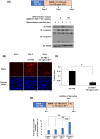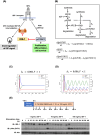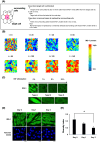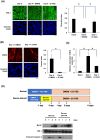IGF-I concentration determines cell fate by converting signaling dynamics as a bifurcation parameter in L6 myoblasts
- PMID: 39237579
- PMCID: PMC11377782
- DOI: 10.1038/s41598-024-71739-y
IGF-I concentration determines cell fate by converting signaling dynamics as a bifurcation parameter in L6 myoblasts
Abstract
Insulin-like growth factor (IGF)-I mediates long-term activities that determine cell fate, including cell proliferation and differentiation. This study aimed to characterize the mechanisms by which IGF-I determines cell fate from the aspect of IGF-I signaling dynamics. In L6 myoblasts, myogenic differentiation proceeded under low IGF-I levels, whereas proliferation was enhanced under high levels. Mathematical and experimental analyses revealed that IGF-I signaling oscillated at low IGF-I levels but remained constant at high levels, suggesting that differences in IGF-I signaling dynamics determine cell fate. We previously reported that differential insulin receptor substrate (IRS)-1 levels generate a driving force for cell competition. Computational simulations and immunofluorescence analyses revealed that asynchronous IRS-1 protein oscillations were synchronized during myogenic processes through cell competition. Disturbances of cell competition impaired signaling synchronization and cell fusion, indicating that synchronization of IGF-I signaling oscillation is critical for myoblast cell fusion to form multinucleate myotubes.
Keywords: Bifurcation analysis; Cell competition; Insulin-like growth factor-I; L6 myoblast; Myogenesis; Signaling dynamics; Signaling oscillation.
© 2024. The Author(s).
Conflict of interest statement
The authors declare no competing interests.
Figures




Similar articles
-
Constitutive expression of insulin receptor substrate (IRS)-1 inhibits myogenic differentiation through nuclear exclusion of Foxo1 in L6 myoblasts.PLoS One. 2011;6(10):e25655. doi: 10.1371/journal.pone.0025655. Epub 2011 Oct 3. PLoS One. 2011. PMID: 21991327 Free PMC article.
-
Myoblasts With Higher IRS-1 Levels Are Eliminated From the Normal Cell Layer During Differentiation.Front Endocrinol (Lausanne). 2020 Feb 28;11:96. doi: 10.3389/fendo.2020.00096. eCollection 2020. Front Endocrinol (Lausanne). 2020. PMID: 32180762 Free PMC article.
-
Muscle-specific overexpression of the type 1 IGF receptor results in myoblast-independent muscle hypertrophy via PI3K, and not calcineurin, signaling.Am J Physiol Endocrinol Metab. 2007 Dec;293(6):E1538-51. doi: 10.1152/ajpendo.00160.2007. Epub 2007 Oct 16. Am J Physiol Endocrinol Metab. 2007. PMID: 17940216
-
Growth hormone and the insulin-like growth factor system in myogenesis.Endocr Rev. 1996 Oct;17(5):481-517. doi: 10.1210/edrv-17-5-481. Endocr Rev. 1996. PMID: 8897022 Review.
-
Type I insulin-like growth factor receptor signaling in skeletal muscle regeneration and hypertrophy.J Musculoskelet Neuronal Interact. 2007 Jul-Sep;7(3):208-18. J Musculoskelet Neuronal Interact. 2007. PMID: 17947802 Review.
References
-
- Fukushima, T. et al. Phosphatidylinositol 3-kinase (PI3K) activity bound to insulin-like growth factor-I (IGF-I) receptor, which is continuously sustained by IGF-I stimulation, is required for IGF-I-induced cell proliferation. J. Biol. Chem.287, 29713–29721. 10.1074/jbc.M112.393074 (2012). 10.1074/jbc.M112.393074 - DOI - PMC - PubMed
MeSH terms
Substances
Grants and funding
LinkOut - more resources
Full Text Sources

